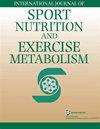限制性饮食和既往低能量骨折与多发性骨应激损伤史相关。
IF 3
3区 医学
Q2 NUTRITION & DIETETICS
International journal of sport nutrition and exercise metabolism
Pub Date : 2022-05-06
DOI:10.1123/ijsnem.2021-0323
引用次数: 4
摘要
骨应力性损伤(bsi)在运动员中很常见,并且复发率很高。然而,多发或复发性脑损伤的危险因素仍未得到充分研究。因此,我们的目的是探讨能量可用性、月经功能、骨骼健康指标和改良的女性运动员三位一体累积风险评估(CRA)工具是否与多发性脑损伤病史相关。我们招募了51名女性跑步者(年龄18-36岁),BSI≤1(对照组;n = 31)或≥3个bsi(多重bsi;N = 20)。我们通过双能x线吸收仪测量腰椎、全髋关节和股骨颈的面骨矿物质密度,使用冲击微压痕测量骨材料强度指数,通过高分辨率外围定量计算机断层扫描测量体积骨矿物质密度、微结构和估计强度。参与者完成了关于病史、低能量骨折史和饮食失调态度的问卷调查。与对照组相比,多发bsi患者先前低能性骨折的发生率更高(55%比16%,p = 0.005),改良的Triad CRA评分更高(2.90±2.05比1.84±1.59,p = 0.04)。多重bsi患者饮食失调检查问卷得分较高(0.92±1.03比0.46±0.49,p = 0.04),当前身高时最低体重与最高体重的百分比差异较大(15.5%±6.5%比11.5%±4.9% p = 0.02)。这些初步研究结果表明,与对照组相比,有多发性脑损伤病史的女性更易发生低能性骨折,并且有更大的历史和目前的能量不足估计。我们的研究结果为未来的研究提供了强有力的理论依据,以检验亚临床指标的能量不足是否与女性跑步者多发脑损伤的风险有关。本文章由计算机程序翻译,如有差异,请以英文原文为准。
Restrictive Eating and Prior Low-Energy Fractures Are Associated With History of Multiple Bone Stress Injuries.
Bone stress injuries (BSIs) are common among athletes and have high rates of recurrence. However, risk factors for multiple or recurrent BSIs remain understudied. Thus, we aimed to explore whether energy availability, menstrual function, measures of bone health, and a modified Female Athlete Triad Cumulative Risk Assessment (CRA) tool are associated with a history of multiple BSIs. We enrolled 51 female runners (ages 18-36 years) with history of ≤1 BSI (controls; n = 31) or ≥3 BSIs (multiBSI; n = 20) in this cross-sectional study. We measured lumbar spine, total hip, and femoral neck areal bone mineral density by dual-energy X-ray absorptiometry, bone material strength index using impact microindentation, and volumetric bone mineral density, microarchitecture, and estimated strength by high-resolution peripheral quantitative computed tomography. Participants completed questionnaires regarding medical history, low-energy fracture history, and disordered eating attitudes. Compared with controls, multiBSI had greater incidence of prior low-energy fractures (55% vs. 16%, p = .005) and higher modified Triad CRA scores (2.90 ± 2.05 vs. 1.84 ± 1.59, p = .04). Those with multiBSI had higher Eating Disorder Examination Questionnaire (0.92 ± 1.03 vs. 0.46 ± 0.49, p = .04) scores and a greater percentage difference between lowest and highest body mass at their current height (15.5% ± 6.5% vs. 11.5% ± 4.9% p = .02). These preliminary findings indicate that women with a history of multiple BSIs suffered more prior low-energy fractures and have greater historical and current estimates of energy deficit compared with controls. Our results provide strong rationale for future studies to examine whether subclinical indicators of energy deficit contribute to risk for multiple BSIs in female runners.
求助全文
通过发布文献求助,成功后即可免费获取论文全文。
去求助
来源期刊
CiteScore
5.00
自引率
8.00%
发文量
50
审稿时长
6-12 weeks
期刊介绍:
The International Journal of Sport Nutrition and Exercise Metabolism (IJSNEM) publishes original scientific investigations and scholarly reviews offering new insights into sport nutrition and exercise metabolism, as well as articles focusing on the application of the principles of biochemistry, physiology, and nutrition to sport and exercise. The journal also offers editorials, digests of related articles from other fields, research notes, and reviews of books, videos, and other media releases.
To subscribe to either the print or e-version of IJSNEM, press the Subscribe or Renew button at the top of your screen.

 求助内容:
求助内容: 应助结果提醒方式:
应助结果提醒方式:


